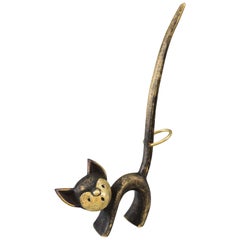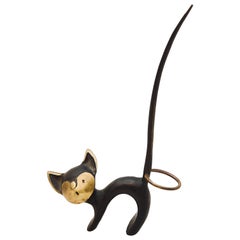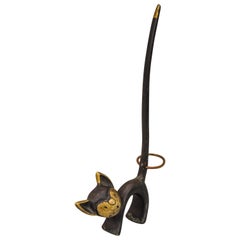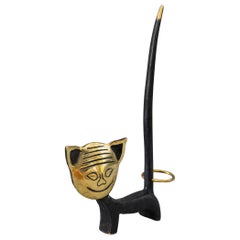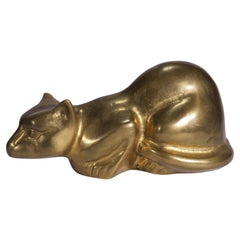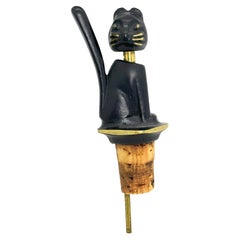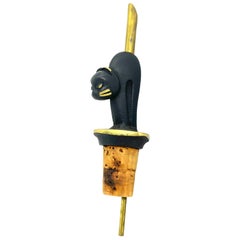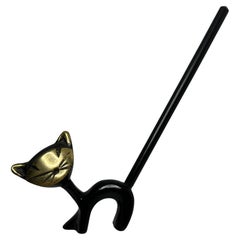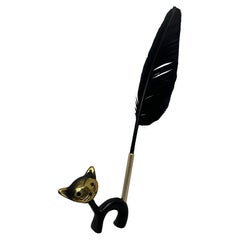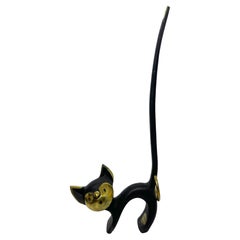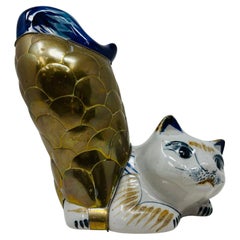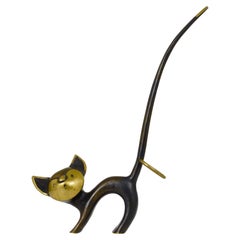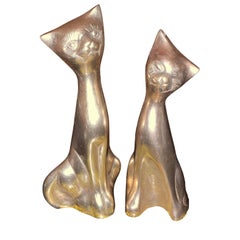Vintage Brass Cat Figurine
1950s Austrian Mid-Century Modern Vintage Brass Cat Figurine
Brass
1950s Austrian Mid-Century Modern Vintage Brass Cat Figurine
Brass
1950s Austrian Mid-Century Modern Vintage Brass Cat Figurine
Brass
1950s Austrian Mid-Century Modern Vintage Brass Cat Figurine
Brass
Mid-20th Century Mid-Century Modern Vintage Brass Cat Figurine
Brass
1950s Austrian Mid-Century Modern Vintage Brass Cat Figurine
Brass, Bronze
1950s Austrian Mid-Century Modern Vintage Brass Cat Figurine
Brass, Bronze
1950s Austrian Mid-Century Modern Vintage Brass Cat Figurine
Bronze, Brass
1950s Austrian Mid-Century Modern Vintage Brass Cat Figurine
Brass, Bronze
1950s Austrian Mid-Century Modern Vintage Brass Cat Figurine
Bronze
1950s Austrian Mid-Century Modern Vintage Brass Cat Figurine
Brass
Mid-20th Century Folk Art Vintage Brass Cat Figurine
Brass
1950s Austrian Mid-Century Modern Vintage Brass Cat Figurine
Brass
1950s Austrian Mid-Century Modern Vintage Brass Cat Figurine
Brass
1950s Austrian Mid-Century Modern Vintage Brass Cat Figurine
Brass
1950s Austrian Mid-Century Modern Vintage Brass Cat Figurine
Brass, Nickel
1950s Austrian Mid-Century Modern Vintage Brass Cat Figurine
Brass
1950s Austrian Mid-Century Modern Vintage Brass Cat Figurine
Brass
1950s Austrian Mid-Century Modern Vintage Brass Cat Figurine
Brass
1950s Austrian Mid-Century Modern Vintage Brass Cat Figurine
Brass
1950s Austrian Mid-Century Modern Vintage Brass Cat Figurine
Brass
1950s Austrian Mid-Century Modern Vintage Brass Cat Figurine
Brass
Mid-20th Century Austrian Mid-Century Modern Vintage Brass Cat Figurine
Brass
Mid-20th Century Austrian Mid-Century Modern Vintage Brass Cat Figurine
Brass
1950s Austrian Mid-Century Modern Vintage Brass Cat Figurine
Brass
20th Century Austrian Mid-Century Modern Vintage Brass Cat Figurine
Bronze
Mid-20th Century Austrian Art Deco Vintage Brass Cat Figurine
Bronze
Recent Sales
Mid-20th Century Austrian Mid-Century Modern Vintage Brass Cat Figurine
Brass
1960s Unknown Mid-Century Modern Vintage Brass Cat Figurine
Brass
Mid-20th Century Austrian Mid-Century Modern Vintage Brass Cat Figurine
Brass
Mid-20th Century American Hollywood Regency Vintage Brass Cat Figurine
Brass
Mid-20th Century Mid-Century Modern Vintage Brass Cat Figurine
Brass
Mid-20th Century Austrian Mid-Century Modern Vintage Brass Cat Figurine
Brass
20th Century Mid-Century Modern Vintage Brass Cat Figurine
Brass
Mid-20th Century Austrian Mid-Century Modern Vintage Brass Cat Figurine
Brass
1950s Austrian Mid-Century Modern Vintage Brass Cat Figurine
Bronze
Mid-20th Century Austrian Mid-Century Modern Vintage Brass Cat Figurine
Brass
20th Century Unknown Modern Vintage Brass Cat Figurine
Stone
1950s Austrian Mid-Century Modern Vintage Brass Cat Figurine
Brass
Mid-20th Century Austrian Mid-Century Modern Vintage Brass Cat Figurine
Brass
Mid-20th Century Austrian Mid-Century Modern Vintage Brass Cat Figurine
Brass
1950s Austrian Mid-Century Modern Vintage Brass Cat Figurine
Brass
1950s Austrian Mid-Century Modern Vintage Brass Cat Figurine
Brass
1950s Austrian Mid-Century Modern Vintage Brass Cat Figurine
Brass, Bronze
1950s Austrian Mid-Century Modern Vintage Brass Cat Figurine
Brass, Bronze
Mid-20th Century Austrian Mid-Century Modern Vintage Brass Cat Figurine
Brass
Mid-20th Century Austrian Mid-Century Modern Vintage Brass Cat Figurine
Brass
Mid-20th Century Austrian Mid-Century Modern Vintage Brass Cat Figurine
Brass
1950s Austrian Mid-Century Modern Vintage Brass Cat Figurine
Brass
People Also Browsed
1950s Austrian Mid-Century Modern Vintage Brass Cat Figurine
Brass
Vintage Brass Cat Figurine For Sale on 1stDibs
How Much is a Vintage Brass Cat Figurine?
Walter Bosse for sale on 1stDibs
Credited with thousands of works and models for ceramic pieces, Walter Bosse was an intensely prolific designer. The modernist Austrian sculptor and ceramist was best known for his distinctive “Black Golden” series of decorative objects and figurines, particularly his hedgehog ashtrays. Bosse’s mid-century and Art Deco works were popular as gifts for politicians and royalty worldwide, remaining coveted among collectors today.
Bosse was born in Vienna in 1904 to artist parents — his father, Julius, was a portrait painter for the Austrian Imperial Court. Bosse studied at the University of Applied Arts in Vienna from 1918 to 1921 under Austrian sculptor Michael Powolny and Austrian painter Franz Cizek. Later, he continued at the Munich School of Applied Arts in Germany under Austrian architect and designer Josef Hoffmann, a founder of the Vienna Secession movement.
Early in his career, Bosse worked as a designer at several ceramics manufacturers, including Augarten Porcelain Works in 1924, Goldscheider Porcelain Manufactory and Majolica Factory in 1926 and Metzler and Ortloff in 1927. In 1925, Bosse displayed several pieces at the International Exposition of Modern Industrial and Decorative Arts in Paris, which introduced the Art Deco style to a global audience.
In 1931, Bosse opened a shop in Kufstein, Austria, selling ceramic gift items. Owing to the crippling economic effects of the Great Depression, however, Bosse was forced to close his shop in 1937. He returned to Vienna in 1938 and opened another business, Bosse Keramik, where he sold toys, glass, textiles and more. In the late 1940s, Bosse experimented with small-scale brass sculptures and desk accessories coated in black ceramic glaze. With Austrian designer Herta Baller, Bosse formed the Bosse-Baller company to manufacture the “Black Golden” line of figurines, which became wildly popular worldwide.
Despite Bosse’s success, he struggled financially and moved to Iserlohn, Germany, in 1953. Meanwhile, Baller continued to manufacture and sell Bosse’s designs, which were so popular that forgers copied and sold counterfeit editions of Bosse’s works around the world. The 1950s marked the debut of the artist’s whimsically zoomorphic hedgehog ashtrays — these were cast in brass, and a hedgehog ashtray in any other material is not a Bosse original.
Bosse spent the rest of his life embroiled in court battles to protect his designs, leaving him penniless by the time he died. Today authentic Bosse pieces — from wall-mounted sculptures to tableware — continue to be highly sought after by collectors.
Find vintage Walter Bosse serveware, wall decorations and more on 1stDibs.
A Close Look at Mid-century-modern Furniture
Organically shaped, clean-lined and elegantly simple are three terms that well describe vintage mid-century modern furniture. The style, which emerged primarily in the years following World War II, is characterized by pieces that were conceived and made in an energetic, optimistic spirit by creators who believed that good design was an essential part of good living.
ORIGINS OF MID-CENTURY MODERN FURNITURE DESIGN
- Emerged during the mid-20th century
- Informed by European modernism, Bauhaus, International style, Scandinavian modernism and Frank Lloyd Wright’s architecture
- A heyday of innovation in postwar America
- Experimentation with new ideas, new materials and new forms flourished in Scandinavia, Italy, the former Czechoslovakia and elsewhere in Europe
CHARACTERISTICS OF MID-CENTURY MODERN FURNITURE DESIGN
- Simplicity, organic forms, clean lines
- A blend of neutral and bold Pop art colors
- Use of natural and man-made materials — alluring woods such as teak, rosewood and oak; steel, fiberglass and molded plywood
- Light-filled spaces with colorful upholstery
- Glass walls and an emphasis on the outdoors
- Promotion of functionality
MID-CENTURY MODERN FURNITURE DESIGNERS TO KNOW
- Charles and Ray Eames
- Eero Saarinen
- Milo Baughman
- Florence Knoll
- Harry Bertoia
- Isamu Noguchi
- George Nelson
- Danish modernists Hans Wegner and Arne Jacobsen, whose emphasis on natural materials and craftsmanship influenced American designers and vice versa
ICONIC MID-CENTURY MODERN FURNITURE DESIGNS
- Eames lounge chair
- Nelson daybed
- Florence Knoll sofa
- Egg chair
- Womb chair
- Noguchi coffee table
- Barcelona chair
VINTAGE MID-CENTURY MODERN FURNITURE ON 1STDIBS
The mid-century modern era saw leagues of postwar American architects and designers animated by new ideas and new technology. The lean, functionalist International-style architecture of Le Corbusier and Bauhaus eminences Ludwig Mies van der Rohe and Walter Gropius had been promoted in the United States during the 1930s by Philip Johnson and others. New building techniques, such as “post-and-beam” construction, allowed the International-style schemes to be realized on a small scale in open-plan houses with long walls of glass.
Materials developed for wartime use became available for domestic goods and were incorporated into mid-century modern furniture designs. Charles and Ray Eames and Eero Saarinen, who had experimented extensively with molded plywood, eagerly embraced fiberglass for pieces such as the La Chaise and the Womb chair, respectively.
Architect, writer and designer George Nelson created with his team shades for the Bubble lamp using a new translucent polymer skin and, as design director at Herman Miller, recruited the Eameses, Alexander Girard and others for projects at the legendary Michigan furniture manufacturer.
Harry Bertoia and Isamu Noguchi devised chairs and tables built of wire mesh and wire struts. Materials were repurposed too: The Danish-born designer Jens Risom created a line of chairs using surplus parachute straps for webbed seats and backrests.
The Risom lounge chair was among the first pieces of furniture commissioned and produced by celebrated manufacturer Knoll, a chief influencer in the rise of modern design in the United States, thanks to the work of Florence Knoll, the pioneering architect and designer who made the firm a leader in its field. The seating that Knoll created for office spaces — as well as pieces designed by Florence initially for commercial clients — soon became desirable for the home.
As the demand for casual, uncluttered furnishings grew, more mid-century furniture designers caught the spirit.
Classically oriented creators such as Edward Wormley, house designer for Dunbar Inc., offered such pieces as the sinuous Listen to Me chaise; the British expatriate T.H. Robsjohn-Gibbings switched gears, creating items such as the tiered, biomorphic Mesa table. There were Young Turks such as Paul McCobb, who designed holistic groups of sleek, blond wood furniture, and Milo Baughman, who espoused a West Coast aesthetic in minimalist teak dining tables and lushly upholstered chairs and sofas with angular steel frames.
Generations turn over, and mid-century modern remains arguably the most popular style going. As the collection of vintage mid-century modern chairs, dressers, coffee tables and other furniture for the living room, dining room, bedroom and elsewhere on 1stDibs demonstrates, this period saw one of the most delightful and dramatic flowerings of creativity in design history.
Finding the Right Animal-sculptures for You
Invite the untamed wonders of the animal kingdom into your home — and do so safely — with the antique, new and vintage animal sculptures available on 1stDibs.
Artists working in every medium from furniture design to jewelry to painting have found inspiration in wild animals over the years. For sculptors, three-dimensional animal renderings — both realistic and symbolic — crisscross history and continents. In as early as 210 B.C., intricately detailed terracotta horses guarded early Chinese tombs, while North America’s native Inuit tribes living in the ice-covered Arctic during the 1800’s wore small animal figurines carved from walrus ivory. Indeed, animal sculpture has a long history, and beginning in the 19th century, the art form started becoming not only fashionable but artistically validated — a trend that continues today. At home, animal sculptures — polished bronze rhinos crafted in the Art Deco style or ceramic dogs of the mid-century modern era — can introduce both playfulness and drama to your decor.
In the case of the frosted glass sculptures crafted by artisans at legendary French glassmaker Lalique, founded by jeweler and glass artist René Lalique, some animal sculptures are purely decorative. With their meticulously groomed horse manes and detailed contours of their parakeet feathers, these creatures want to be proudly displayed. Adding animal sculptures to your bookcases can draw attention to your covetable collection of vintage monographs, while side tables and wall shelving also make great habitats for these ornamental animal figurines.
Some sculptures, however, can find suitable nests in just about any corner of your space. Whimsical brass flamingos or the violent, realist bronze lions created by Parisian sculptor Antoine-Louis Barye are provocative and versatile pieces that can rest on windowsills or your desk. Otherwise, the brass cat shoehorns and bronze porcupine ashtrays designed by Viennese artist Walter Bosse are no longer roaming aimlessly throughout your living room, as they’ve found a purpose to serve.
Embark on your safari today and find a fascinating collection of vintage, modern and antique animal sculptures on 1stDibs.
